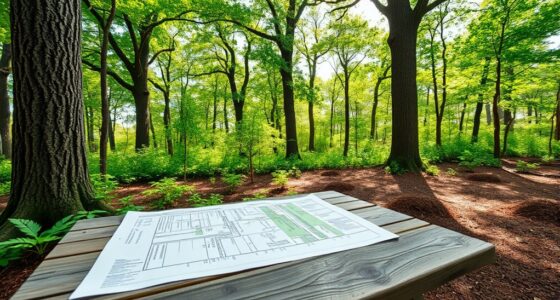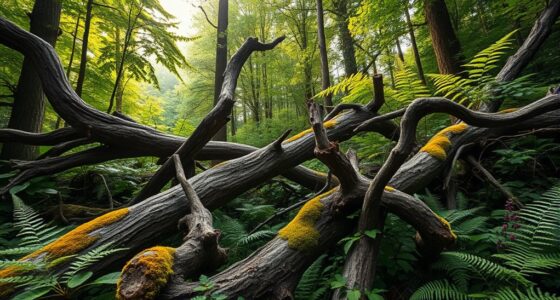Timber stand improvement boosts firewood quality by promoting healthier, faster-growing trees with denser, more solid wood. You can achieve this by selectively thinning overcrowded or weak trees, which reduces competition and improves air circulation. Managing invasive species keeps your forest balanced and prevents poorer-quality stands. Monitoring your forest regularly helps maintain its resilience. Keep these practices in mind, and you’ll discover how proper management leads to better firewood and healthier forests over time.
Key Takeaways
- Thinning overcrowded trees enhances growth, resulting in larger, denser firewood with higher energy content.
- Removing weak, diseased, or damaged trees improves overall stand health and firewood quality.
- Managing invasive species prevents competition, promoting native trees with better wood for firewood.
- Selecting the strongest, straightest trees during thinning ensures higher-quality, easier-to-harvest firewood.
- Regular monitoring and maintenance sustain forest health, ensuring ongoing production of high-quality firewood.

Timber stand improvement (TSI) is a vital process for enhancing forest health, productivity, and timber quality. When you’re aiming to produce high-quality firewood, TSI plays a crucial role in shaping a healthier, more manageable forest. One essential aspect of TSI involves forest thinning, which reduces overcrowded trees and allows the remaining ones to grow stronger and straighter. By selectively removing weaker, diseased, or overcrowded trees, you improve air circulation, reduce competition for nutrients, and promote the growth of larger, more valuable trees. This process results in timber that burns better, produces less smoke, and has a higher energy content—perfect for firewood.
In addition to thinning, managing invasive species is a key part of effective TSI. Invasive plants and trees can quickly dominate a forest, choking out native species and disrupting the natural balance. If you leave invasive species unchecked, they can lead to dense, unhealthy stands that produce inferior firewood. Removing or controlling invasive species early on helps maintain a diverse, resilient forest. This, in turn, improves the quality of the timber you harvest for firewood, as native trees tend to be healthier and more uniform in size and quality. The removal of invasives also reduces competition for resources, ensuring that desirable species can thrive and develop thicker, more solid wood, which is ideal for burning. Regular monitoring of the forest and understanding forest succession can help you plan effective management strategies for long-term forest health and firewood quality.
As you implement forest thinning, you should focus on selecting the right trees to remove. It’s best to target weaker, less desirable trees, and focus on maintaining the strongest, straightest, and healthiest specimens. This will ensure that the remaining trees grow into more valuable timber, which translates into better firewood. Proper thinning not only boosts timber quality but also enhances the forest’s overall structure, making it easier to access and harvest firewood later. Regularly monitoring your stand for invasive species and removing them promptly prevents future issues that could compromise your firewood supply.
Frequently Asked Questions
How Often Should Timber Stand Improvements Be Performed?
You should perform timber stand improvement every 10 to 15 years, depending on the stand’s growth rate and health. The ideal timing is during the late winter or early spring when trees are dormant, making it easier to assess and selectively remove undesirable trees. Regularly scheduling these improvements ensures your stand remains healthy, productive, and yields high-quality firewood by promoting better growth and reducing competition.
What Tree Species Are Best for Firewood Quality?
You should choose fast-growing species like oak, hickory, or black walnut for the best firewood quality. These species have high energy content, produce dense, long-burning logs, and have favorable growth rates that guarantee a steady supply. By selecting the right species based on growth rates and wood density, you’ll get superior firewood that burns efficiently and produces ample heat, making your firewood stand much more effective and enjoyable.
How Does Stand Improvement Affect Overall Forest Health?
Stand improvement acts like a gardener tending a vibrant garden, boosting forest health by nurturing soil health and increasing biodiversity. You’ll remove unhealthy or invasive trees, allowing native species to thrive. This process promotes stronger, more resilient forests that resist pests and diseases. As a result, your forest becomes a healthier ecosystem, supporting diverse wildlife and ensuring sustainable timber and firewood resources for years to come.
Are There Specific Tools Required for Timber Stand Improvement?
You’ll need specific tools for timber stand improvement, mainly harvesting equipment like chainsaws and skidders, to efficiently carry out thinning techniques. These tools help you selectively remove weaker or overcrowded trees, promoting healthier growth. Proper equipment makes the process safer and more effective, ensuring you can manage the stand properly. Make sure to select the right tools for your specific site and tree types to maximize your improvement efforts.
What Are the Costs Associated With Timber Stand Improvement?
Imagine you’re stepping into a time machine—costs for timber stand improvement vary widely, from a few hundred to several thousand dollars depending on your project size and methods. You should do a thorough cost analysis and develop budgeting strategies to manage expenses effectively. Expect to invest in tools, labor, and possibly consulting experts, but careful planning guarantees you maximize benefits without overspending.
Conclusion
So, next time you’re out trying to impress your friends with your firewood, remember that timber stand improvement isn’t just for tree nerds. It’s about making sure your firewood is first-rate—less smoke, more heat, and fewer splinters. Skip the chaos of random cutting and let nature do the heavy lifting. Trust me, your future self will thank you, especially when you’re roasting marshmallows over a fire that actually burns well. Cheers to smarter firewood!









